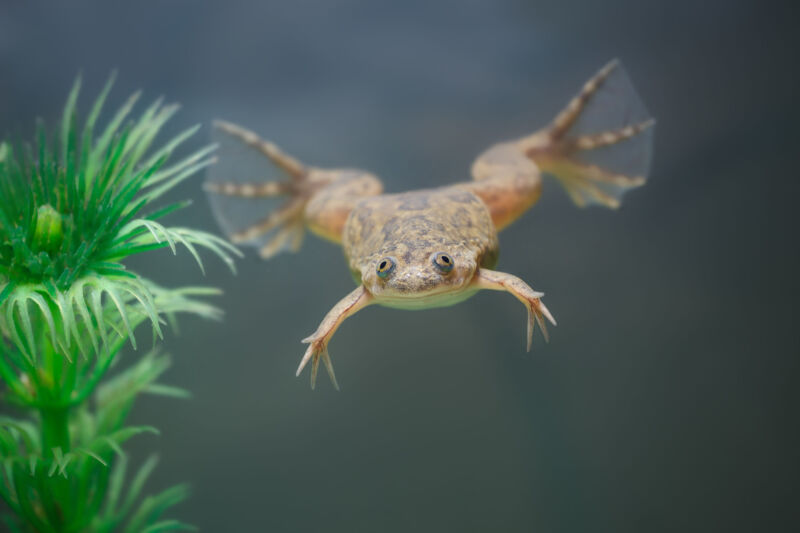Xenopus: A Unique Aquatic Model for Research and Discovery
The Xenopus genus, commonly called the African clawed frogs, is a remarkable group of aquatic amphibians widely used in scientific research. Among the 20 species in this genus, Xenopus laevis and Xenopus tropicalis are most commonly studied. Their unique biological traits, adaptability, and regenerative qualities have made them indispensable in fields ranging from developmental biology to toxicology.
Habitat and Natural History
Native to sub-Saharan Africa, Xenopus frogs inhabit slow-moving rivers, lakes, and ponds. They are fully aquatic and capable of thriving in diverse water conditions, including temporary water bodies. This adaptability stems from their ability to aestivate during dry seasons and tolerate varying water qualities.
Physical Characteristics
Xenopus species are easily identifiable by their flattened bodies, smooth skin, and clawed hind feet. Unlike most frogs, they lack a tongue and use their hands to push food into their mouths. Xenopus laevis, the most common species, can grow up to 12 cm in length and exhibits a grayish-green coloration with distinctive mottling.

Why Xenopus? A Model Organism for Research
Unique Developmental Traits
The Xenopus embryo develops externally, allowing researchers to observe and manipulate its development in real-time. The large, transparent eggs are ideal for studying cellular processes, such as fertilization and genetic manipulation.
Genetic Insights
Xenopus tropicalis was the first amphibian to have its genome sequenced. With a diploid genome, it serves as a powerful model for genetic studies, complementing Xenopus laevis, which has a tetraploid genome.
Versatility in Research
- Developmental Biology: Xenopus is instrumental in understanding vertebrate development, including neural, muscular, and organ formation.
- Regenerative Medicine: These frogs have an impressive ability to regenerate tissues, providing insights into potential human applications.
- Toxicology: Their sensitivity to environmental pollutants makes them valuable for testing chemical effects on biological systems.
Key Applications in Scientific Studies
- Study of Early Development: The rapid development of Xenopus embryos, coupled with their large size, makes them ideal for studying embryogenesis. Researchers can easily manipulate their eggs to understand cellular differentiation and organogenesis.
- Human Disease Models: Due to their genetic similarities with humans, Xenopus frogs are used to study various conditions, including cancer, kidney diseases, and metabolic disorders. Their eggs can be injected with human genes to analyse protein functions and disease mechanisms.
- Neuroscience and Regeneration: The regenerative capabilities of Xenopus, particularly their ability to regrow limbs and parts of the nervous system, are paving the way for breakthroughs in regenerative medicine. These studies hold promise for treating spinal cord injuries and neurodegenerative diseases in humans.
Innovations in Xenopus Care and Preservation
Companies like Iwaki Aquatic play a vital role in ensuring optimal environments for Xenopus in research and aquaculture settings.
- Water Quality Management: Xenopus frogs thrive in clean, oxygenated water with stable pH levels. Advanced filtration and water quality monitoring are essential for maintaining water quality, preventing stress, and minimizing disease.
- Temperature and Lighting: Optimal temperatures for Xenopus laevis species range from 16°C to 20°C and Xenopus tropicalis species range from 24°C to 28°C. Automated temperature control systems and appropriate lighting setups mimic their natural habitats, ensuring healthy growth and behavior.
- Feeding Solutions: These frogs are omnivorous, feeding on aquatic invertebrates, algae, and prepared diets. Automated feeding systems can ensure consistent and adequate nutrition, particularly in large-scale facilities.
- Monitoring Technologies: Innovative monitoring tools track water conditions, ensuring that parameters such as ammonia, nitrate, and dissolved oxygen levels remain within safe ranges. Early detection of fluctuations helps in mitigating risks promptly.
Breeding and Husbandry
Breeding Techniques
Breeding Xenopus frogs requires specific conditions to stimulate reproduction:
- Hormonal Induction: Injections of human chorionic gonadotropin (hCG) are used to trigger ovulation and sperm production.
- Spawning Setup: A shallow breeding tank encourages natural mating behavior.
- Egg Collection: Eggs should be collected promptly to prevent predation and contamination.
Housing and Maintenance
- Tank Design: Spacious tanks with smooth surfaces prevent injury to these active swimmers.
- Hygiene Protocols: Regular cleaning and water changes reduce the risk of infections and maintain a healthy environment.
Conservation and Ethical Practices
The increasing use of Xenopus in laboratories highlights the importance of ethical practices in their care and usage.
- Ethical Guidelines: Organizations like the National Institutes of Health (NIH) and the Animal Research Advisory Committee (ARAC) provide guidelines for humane handling and care of Xenopus
- Sustainable Sourcing: Wild populations of Xenopus are under pressure from habitat loss and overcollection. Sustainable breeding programs in captivity reduce the impact on natural populations while meeting research demands.
- Reducing Stress: Minimizing handling, providing hiding spaces, and maintaining stable environments are essential for reducing stress in captive Xenopus.
The Role of Xenopus in Environmental Monitoring
Apart from laboratory research, Xenopus species are also used as bioindicators to monitor environmental health. Their sensitivity to waterborne pollutants and hormonal disruptors offers critical insights into ecological changes and potential risks to human health.
As scientific techniques advance, the scope of Xenopus research continues to grow. The integration of CRISPR gene-editing technology and high-throughput screening methods is expanding our understanding of human biology and disease.
For businesses like Iwaki Aquatic, supporting Xenopus care through innovative technologies and sustainable practices ensures that these fascinating amphibians continue to thrive in both research and conservation settings.



